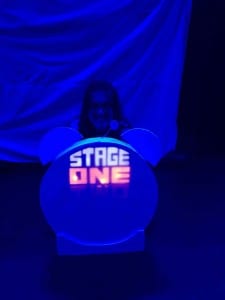Hi everyone!
The last couple of weeks have been intense but the show is really coming together now and we are so excited to perform in a few weeks. I wanted to write about the structure of our show today, and how I have attempted to turn into a jigsaw puzzle master in order to piece the show together.
Very early on I decided that the most logical, and interesting, way to structure out show would be using the five stages of sleep. Our amazing set designer Amanda has made a clock that reflects these stages, the following image is of this clock.

Throughout the performance we will use music and this clock in order to transition from one stage of sleep to another. The tempo of the music will reflect the speed of brainwaves during each stage of sleep, which I think is so cool!
When sorting all of our scenes into a stage of the sleep cycle I have had to think about both where these scenes would sit logically, and how the scenes in each stage would work together to bring light and shade throughout. I decided very early on that I would not move the sleep disorder sections around as most of these occur in a certain stage of sleep, for instance sleep paralysis occurs during REM sleep. Therefore, every sleep disorder/verbatim scene has remained in its correct stage. The issue then came with fitting the rest of the puzzle around the verbatim.
The structure of the show has changed many times as the scenes have evolved, but now that we have a full show the structure has been set. In order to fit this jigsaw puzzle of a performance together I have had to write down what happens in every scene and try and pair light and dark scenes together, for example night terrors (arguably our darkest and most emotive scene) is in stage three, followed by one of our comedy bedtime stories. The reason for this is that our show is designed to represent different experiences of sleep; some people love the idea of sleep, others dread it. Not only this, but the mixture of scenes and rapid transitions mimic the structure of a dream. In combining the light and shade I hope to provide the audience with an accurate representation of experiences of sleep.
Finally, the show is cyclical. It both starts and ends with Emma struggling to get to sleep. This cyclicality mimics the sleep cycle, as when your body finishes REM sleep (the final stage) it begins the cycle all over again.
Though solving this jigsaw puzzle, and fitting all of our scenes together, hasn’t been easy, I am now confident that the structure of our show is cohesive; both accurately and interestingly representing a good night’s sleep.
E.W.
Works Cited:
Mason, A. (2018) The Truth About Bedtime Clock. [photograph] (Lucy Farrell’s private photograph).